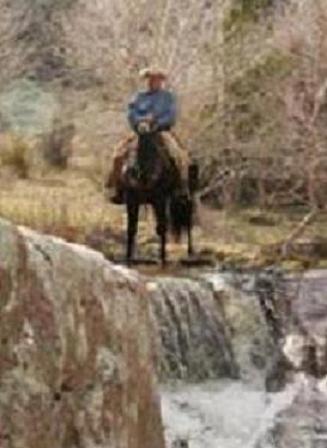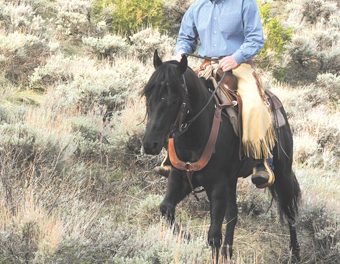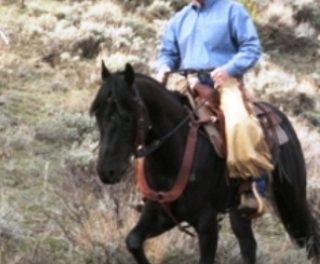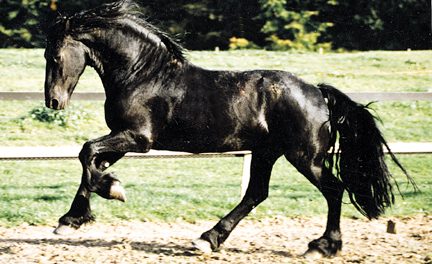 This month, we will continue our series on how to start a colt under saddle. Before you start this month’s exercises, review last month’s round pen training to make sure your horse remembers everything and is listening to you.
This month, we will continue our series on how to start a colt under saddle. Before you start this month’s exercises, review last month’s round pen training to make sure your horse remembers everything and is listening to you.
For the exercises we will cover today, you will need support boots for your horse’s legs, a rope halter with a 12’ lead rope, a Navajo type saddle blanket that can be folded and unfolded easily, whatever saddle pad you like to ride in, and your saddle and anything you normally ride with such as a back cinch or breast collar.
Bring your horse to the round pen, make sure he is wearing his support boots, and review the exercises from last month. Then put on the halter and lead rope. The halter should be tight enough that the noseband sits just above the soft cartilage of the nose, so it doesn’t cut off your horse’s air. Sack your horse out with the lead rope, starting at his head and working back over his entire body. Rub it gently but firmly along his head, over his ears, down his neck, over his back, down all four legs, and put the rope around his belly and tighten it gently like it was a front cinch and back cinch. Don’t use the halter to hold your horse still. If he does move off or spook, just work him a little on the lead rope but don’t make a big deal of it, then go back to what you were doing.
After your horse is completely comfortable with the lead rope being all over his body, you are ready to move on to sacking him out with the saddle blanket. Start with the blanket folded up small, and gradually unfold it larger and larger as your horse gets used to it. Repeat the process you did with the lead rope, rubbing the blanket all over his body. I want to mention a few core principles of sacking out here. First, when you are training you may hear “I don’t want to make my horse bored with this.” That is true for some things, but this is one area where I want to do it until my horse is completely bored. When he is bored, that tells me that he is truly not concerned or feeling any fear around what we are doing. Next, for this part of the training, your goal is for your horse to keep his feet still through all the exercises. It’s your job to try and anticipate if he is getting scared enough that he is about to move off, and if you sense that is about to happen, stop the exercise and give him a break BEFORE he moves. But, if he moves off before you can do that, don’t stop what you are doing. Stay with him until his feet are still again, THEN release the pressure and give him a little break. Last, when you are sacking out, everything you do to one side of the horse must be repeated on the other side. So work each of these steps from both the right and left.
Once your horse is comfortable with the saddle blanket completely unfolded being draped all over him and swung up on him, you can move on to sacking him out with the saddle pad that you are actually going to put under your saddle. Put it up on him and take it off a bunch of times from each side. Let him feel the weight and pat the pad so he can hear any noises it makes. Remember to take the pad off as a release regularly, and pet your horse to reassure him through all of this. The next step is the saddle itself. Take the saddle and swing it smoothly on to your horse’s back. Don’t try to sneak it up there. Just saddle him as you would any horse. Leave the saddle on his back for only a few seconds and take it off again. After you have swung the saddle up on him enough that he doesn’t seem to mind any more, let down your cinches. Stand in front of the shoulder as you reach under his belly for the cinches the first few times so you are out of the way if he does anything unexpected. Tighten the front cinch a little, and let it drop away.
When you are at this point, be careful not to end up in a place where your saddle is cinched up very loosely. Either have it so you can drop the cinch and let the saddle slip off if your horse takes off, or have it cinched up tight enough that it will stay on his back if he moves. What you want to avoid is having your horse take off and end up with the saddle hanging around his belly. Once you have let your horse feel the cinch and released it a few times, tighten it up and put on any other accessories you have on your saddle like a back cinch or breast collar. When everything is hooked up and tight, ask your horse to move off on the lead rope around you. Make sure you watch him closely and stay in a place where you will be safe if he suddenly jumps forward. If he moves off without caring about the saddle, that’s great. If he starts bucking, you don’t want to make it into a huge deal, but you do want him to know that’s not good behavior. Bump the lead rope and keep asking him to go forward until he stops bucking. Let him move around and get used to the feel of the saddle on his back. Once he is moving forward smoothly in both directions, stop him and let him stand again. Sack him out with the saddle by snapping the stirrup leathers, slapping the seat of the saddle with your hands, and anything else you can think of. Once your horse is comfortable with that, take off the halter and send him off around the pen. Ask him to move forward in both directions at all three gaits. If he starts to buck at any point, turn him immediately. Once you have smooth relaxed movement at all three gaits, you are at a great stopping point. Take off the saddle and put your horse away.
We have covered a lot of material, and although you can do all of these steps in one session, you surely don’t have to. The more time you spend on this process, the better. Progress at whatever speed you are comfortable with and break these exercises into as many sessions as you want.
The point of all the exercises we covered today is to make your first ride safe and successful. I have found that if a horse bucks on the first ride, it is usually caused by a mistake or omission in this part of the training. So take your time with this process and make sure it is done very thoroughly. When you go to get on your horse’s back for the first time, you will be glad you did!
Enjoy your horses and until next time, may God bless the trails you ride.
For more information on Ken McNabb’s programs call us at 307-645-3149 or go to www.kenmcnabb.com





